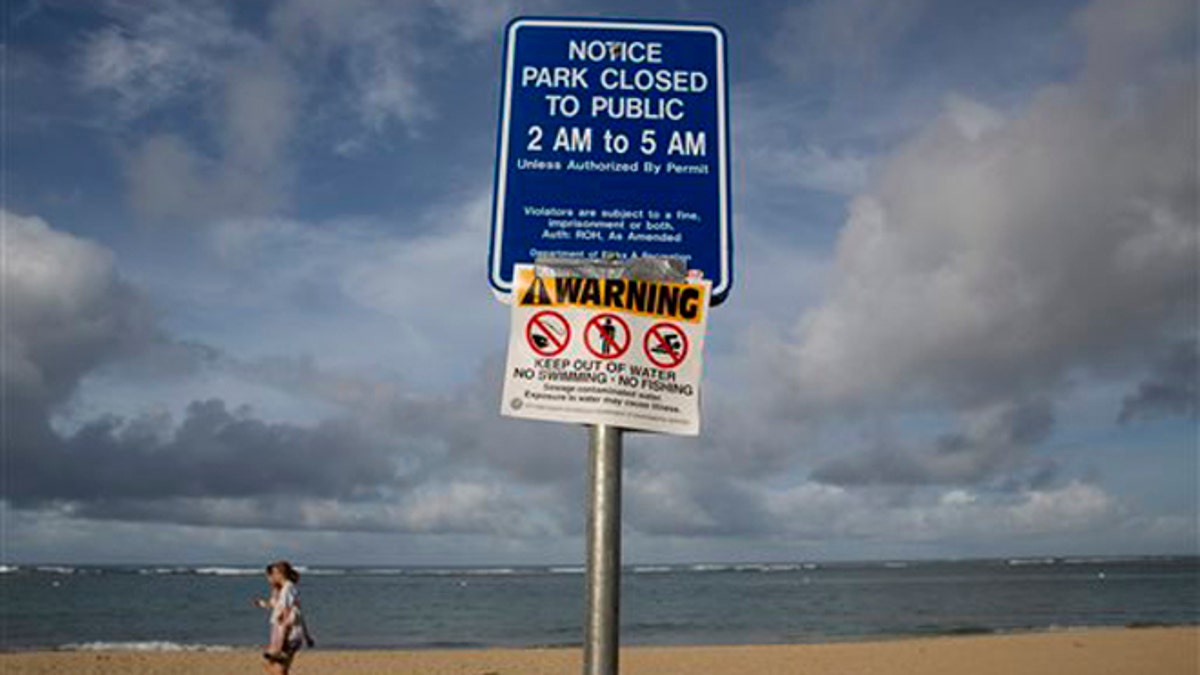
Aug. 25, 2015: Tourists walks near a warning sign posted on Waikiki Beach in Honolulu. Most of the famed beach fronting Waikiki was closed after heavy rains triggered a half-million gallon sewage spill near Hawaii's world-famous tourist district, officials said. (AP Photo/Jae C. Hong)
HONOLULU – Stretches of Waikiki's white sands and blue waters were deserted Tuesday after officials warned that heavy rains triggered a half-million-gallon sewage spill near Hawaii's world-famous tourist district.
Still, dozens of tourists waded into the water, and young parents carried their toddlers into the ocean, ignoring the warning signs about unsafe water.
Carmen Antaky went swimming in Waikiki with her friend Sloan Hill-Lindsay on Tuesday. "I guess a lot of people are freaked out about it. We still jumped in," Antaky said.
They said they go in the water every day and were willing to take their chances. "We're also from L.A., where it's pretty polluted anyways," Hill-Lindsay added.
The heavy rains overwhelmed the sewage system Monday morning, causing 500,000 gallons of wastewater to spew from manholes, said Lori Kahikina, Honolulu's director of environmental services. "Now's not the time to go swimming," she told reporters on Monday.
Lifeguards gave verbal warnings that the water was polluted, but they do not have enforcement powers so all they could do was warn visitors, officials said.
Peter Parhar, from Vancouver, British Columbia, who was also on Waikiki Beach Tuesday, said the infrastructure should be improved and he was concerned about the city's communication of the issue.
"More should be done to inform the beach patrons of the risks of being in the water," Parhar said. "For the tourist segment that isn't English-speaking, they have no idea what's going on and they're carrying little infants into the water."
The city is advising people to avoid a 4-mile stretch of waterfront from Kapahulu Avenue in Waikiki to Point Panic in Kakaako. Sewage came out of manholes at Ala Moana Beach Park, on a street fronting a shopping mall at the edge of Waikiki and a pumping station. The park is closed, and Honolulu police are keeping people away.
Waikiki was not the only area of Oahu that was affected by an overflow of wastewater. The state Department of Environmental Services said that Kailua, Kaneohe and Kalanianaole Highway in Aina Hina also experienced overflowing sewer systems. The Department of Health issued warnings for people to stay out of the water in all affected areas, including Kaneohe and Mamala bays.
Shayne Enright, a spokeswoman for the city's Department of Emergency Services, cautioned that the ocean was dangerous. "We don't know right now what is in the water. You could get a serious infection, get extremely sick or even worse," she said.
Kahikina said the storm water entered the sewage system as leaves and debris clogged the storm drains. Some witnesses reported people were opening manhole covers to let the storm water drain into the sewage system, even though sewage pipes and pumps aren't designed to handle that volume of liquid, she said.
It's illegal to open manhole covers, Kahikina added.
In 2006, the city temporarily closed Waikiki's beaches after 48 million gallons of raw sewage poured into the Ala Wai Canal bordering the area's hotels and condominiums. That spill occurred after a sewage line ruptured following weeks of heavy rains, forcing the city to divert wastewater into the canal.
Lifeguards were warning visitors to all island beaches about a brown-water advisory issued by the Department of Health saying that flood waters might be contaminated.
The entire state remained under a flash-flood watch again Tuesday, with more rain expected. This year's hurricane season, which lasts through the end of November, has been particularly active.
A new tropical storm, Ignacio, formed east of the Hawaiian Islands on Tuesday and is forecast to become a hurricane by Thursday, Central Pacific Hurricane Center Meteorologist Chevy Chevalier said. "It's an above-average year already, and we're still just in August," he added.
There have been 17 storms so far this year in the Pacific, 12 of which reached hurricane status, according to the National Weather Service. Six of those storms reached super-typhoon status, which means they had maximum sustained winds over 150 mph.
Although it's too early to predict, Ignacio's current path could take it near or over the islands, Chevalier said.
"The reason for the forecast of an above average tropical season in the Pacific this year is El Nino conditions," Chevalier said in an email. "El Nino typically brings this area above normal sea surface temperatures and less vertical wind shear, both of which normally lead to tropical cyclone intensification."

